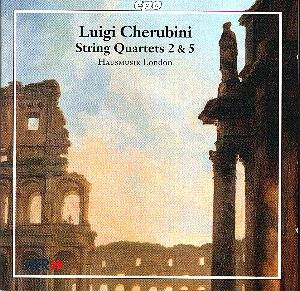Luigi CHERUBINI (1760 -1842)
String Quartet No 2 in C Major (1829) 29'11"
String Quartet No 5 in F Major (1835) 25'43"
 HAUSMUSIK London Monica Hugget,
Pavlo Beznosiuk , (violins) Roger Chase, (viola); Richard Lester (cello).
HAUSMUSIK London Monica Hugget,
Pavlo Beznosiuk , (violins) Roger Chase, (viola); Richard Lester (cello).
 Recorded June 24 -26 1997
Kammermusik Studio
Recorded June 24 -26 1997
Kammermusik Studio
cpo 999 4642 DDD [54'54"]
Crotchet
Amazon UK Amazon USA

Nowadays something of a remote figure - respected but out on the fringes
- we must recall how highly Cherubini was regarded in his heyday. Beethoven
regarded him as the greatest living composer and his republican views and
theatrical approach influenced Fidelio. He wrote church music, stage
and operatic works but his sole attempt at 'pure' music in a multi-movement
setting - his symphony of 1814 - failed to set the world alight. He wrote
six Quartets in all, most of them outpourings from an old man, none of which
has been recorded often or has become established in the repertoire.
That poorly received Symphony eventually became the basis of his Second Quartet
of 1829. Cherubini used three movements from the earlier work, discarded
the slow movement, and wrote a completely new Lento to replace it.
The result was a standard four-movement work. The dramatic slow introduction
leads to a sparkling Allegro that dazzles and bubbles over. The second
movement marked Lento is something of a puzzle. Structured in sections,
with mood and tempo changes that appear to come almost from nowhere, it has
prominent writing for the lead violin and a sad, lingering ending as if the
composer was reluctant to let go. This prominence of the lead violin continues
in the short Scherzo while the Finale is brilliantly played
if unconvincing.
The Quartet Number 5, dates from 1835 when Cherubini, long finished with
his stage and operatic work, seemed to be dedicating himself to the form.
After a typical slow opening the Moderato Assai reveals some fine
inner-part writing in the sharing of small phrases, and the repeated short
motif in the Adagio has an almost soporific effect. The slightly
mysterious pianissimo ending reminds us that Cherubini was 75 when he wrote
the piece. The scherzo again shows the composer writing in short phrases
and in fractured sections with the first violin reaching almost to the upper
limit of its range. The work ends with a Finale prominently involving
the lead violin (again), a rapid-fire fugue, and a vigorous close.
Hausmusik is deservedly well-known and acknowledged in its field of period
performance. Intonation and execution are impeccable and the recording is
excellent. The two Quartets featured are interesting for an occasional hearing
but are not from the top drawer of their field. But devotees of the genre
may well be tempted to try something new.
Reviewer
Harry Downey

